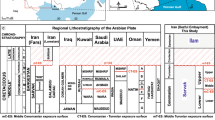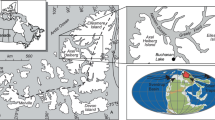Abstract
THE discovery of high concentrations of iridium in Cretaceous/Tertiary boundary sediments engendered the hypothesis1 that a meteorite collided with the Earth 65 million years ago, coincident with the mass extinction that occurred at that time. Iridium spikes of various magnitudes have subsequently been reported at more than 10 other extinction horizons2–11. It has been suggested, on the other hand, that geochemical processes might create or modify many of these spikes5, 11–4, but a critical evaluation of these suggestions has been hindered by incomplete understanding of low-temperature iridium geochemistry. Other platinum-group elements (Ru, Rh, Pd, Re, Os, Pt, Au) are often found to be associated with Ir spikes, and inter-element ratios have been used to assess the cosmic or terrestrial nature of the enrichments5,7,9,28,29; but the geochemical influences on these relative abundances are also poorly constrained. Here we describe analyses of recent abyssal marine sediments which allow us to characterize the behaviour of Pt, Re and Ir during early diagenesis. These elements are redistributed by changes in sedimentary redox conditions. Such changes can probably account for many of the small platinum-group-element spikes found in the geological record, and may render ambiguous attempts to interpret inter-element ratios.
This is a preview of subscription content, access via your institution
Access options
Subscribe to this journal
Receive 51 print issues and online access
$199.00 per year
only $3.90 per issue
Buy this article
- Purchase on Springer Link
- Instant access to full article PDF
Prices may be subject to local taxes which are calculated during checkout
Similar content being viewed by others
References
Alvarez, L. W., Alvarez, W., Asaro, F. & Michel, H. Science 208, 1095–1108 (1980).
Alvarez, W., Asaro, F., Michel, H. V. & Alvarez, L. W. Science 216, 886–888 (1982).
Xu, D.-Y. et al. Nature 314, 154–156 (1985).
Ganapathy, R. Science 216, 885–886 (1982).
Holser, W. T. et al. Nature 337, 39–44 (1989).
Hsu, K. J. et al. Nature 316, 809–811 (1985).
Kyte, F. T., Zhou, Z. & Wasson, J. T. Nature 292, 417–420 (1981).
Orth, C. J., Quintana, L. R., Gilmore, J. S., Grayson, R. C. Jr & Westergaard, E. H. Geology 14, 986–990 (1986).
Orth, C. J. et al. Geology 16, 627–630 (1988).
Orth, C. J. et al. Geophys. Res. Lett. 15, 346–349 (1988).
Playford, P. E., McLaren, D. J., Orth, C. J., Gilmore, J. S. & Goodfellow, W. D. Science 226, 437–439 (1984).
Wallace, M. W., Keays, R. R. & Gostin, V. A. Geology 19, 551–554 (1991).
Schmitz, B. Geochim. cosmochim. Acta 49, 2361–2370 (1985).
Wallace, M. W., Gostin, V. A. & Keays, R. R. Geology 18, 132–135 (1990).
Barker, J. & Anders, E. Geochim. cosmochim. Acta 32, 627–645 (1968).
Crocket, J. H. & Kuo, H. Y. Geochim. cosmochim. Acta 43, 831–842 (1979).
Goldberg, E. D., Hodge, V., Kay, P., Stallard, M. & Koide, M. Appl. Geochem. 1, 227–232 (1986).
Koide, M. et al. Appl. Geochem. 1, 705–714 (1986).
Colley, S., Thomson, J., Wilson, T. & Higgs, N. Geochim. cosmochim. Acta 48, 1223–1235 (1984).
Thomson, J., Higgs, N. C. & Colley, S. Mar. Geol. 89, 315–330 (1989).
Thomson, J., Higgs, N. C., Croudace, I. W., Colley, S. & Hydes, D. J. Geochim. cosmochim. Acta (in the press).
Wilson, T. R. S. et al. Geochim. cosmochim. Acta 49, 811–822 (1985).
Jarvis, I. & Higgs, N. in Geology and Geochemistry of Abyssal Plains (eds Weaver, P. P. E. & Thomson, J.) 179–213 (Geol. Soc. Spec. Publ., London, 1987).
Colley, S., Thomson, J. & Toole, J. Geochim. cosmochim. Acta 53, 1223–1234 (1989).
Colodner, D. C. thesis, Massachusetts Inst. Technol—Woods Hole Oceanogr. Inst. (1991).
Jacinto, G. S. & van den Berg, C. M. G. Nature 338, 332–334 (1989).
Anders, E. & Ebihara, M. Geochim. cosmochim. Acta 46, 2363–2380 (1982).
Kyte, F. T., Zhou, Z. & Wasson, J. T. Nature 288, 651–656 (1980).
Ganapathy, R. Science 209, 921–923 (1980).
Author information
Authors and Affiliations
Rights and permissions
About this article
Cite this article
Colodner, D., Boyle, E., Edmond, J. et al. Post-depositional mobility of platinum, iridium and rhenium in marine sediments. Nature 358, 402–404 (1992). https://doi.org/10.1038/358402a0
Received:
Accepted:
Issue Date:
DOI: https://doi.org/10.1038/358402a0
This article is cited by
-
Widespread elevated iridium in Upper Triassic–Lower Jurassic strata of the Newark Supergroup: implications for use as an extinction marker
Scientific Reports (2020)
-
Enhanced flux of extraterrestrial 3He across the Permian–Triassic boundary
Progress in Earth and Planetary Science (2019)
-
Osmium isotope evidence for a large Late Triassic impact event
Nature Communications (2013)
-
Mineral chemistry of clays associated with the Jhilmili intertrappean bed in the eastern Deccan volcanic province: Palaeoenvironmental inferences and KTB transition
Journal of the Geological Society of India (2013)
-
Ppt range iridium determination by RNAA and application of that method on a Permian/Triassic boundary section, Bálvány, Bükk Mts., Hungary
Journal of Radioanalytical and Nuclear Chemistry (2012)
Comments
By submitting a comment you agree to abide by our Terms and Community Guidelines. If you find something abusive or that does not comply with our terms or guidelines please flag it as inappropriate.



